Garnacha: Comando G, La Bruja de Rozas 2017 – Pairing Rating: 9.5 out of 10.0
Grenache: Domaine Santa Duc Gigondas Grand Grenache 66 2010 – Pairing Rating: 9.0
The earliest known use of the word “sausage”, from the Latin salsus (salted), can be found in Homer’s The Odyssey (XX : 24-27), circa 700 BCE. Since then, sausages continued to hang in the halls of history, linked to numerous historical figures: the Aristophanes’ play The Knights is about a sausage vendor who is elected leader; sausages were associated with the Lupercalia pagan festival during the reign of Nero; in 320 AD, Constantine I and the Catholic Church banned sausage eating because of ties to such pagan festivals; and in the 10th century, Byzantine Emperor Leo VI, the Wise, outlawed the production of blood sausages following cases of food poisoning.
Today, we link sausages with casual, comfort food: brats at the ballpark, sausage & peppers at a county fair, sausage (Würstl) & sauerkraut at Oktoberfest. Trish and I wanted to think outside the bun and in doing so found this excellent recipe from Fine Cooking magazine (detailed at the bottom of this post):
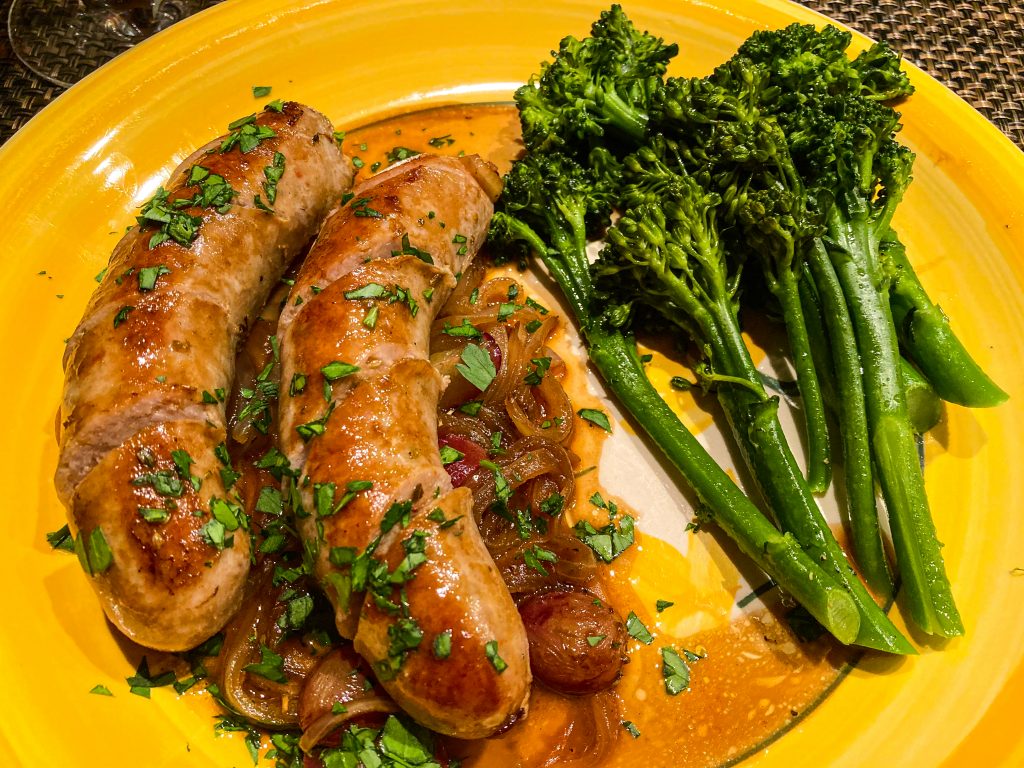
The salty, spicy juices of the sausage, the tang of the balsamic vinegar and the sweetness of the onions & grapes, commingle in a way that separates this recipe from other sausage dishes. The preparation is straightforward, hastened by having all the elements at the ready – so called, Mise en Place.
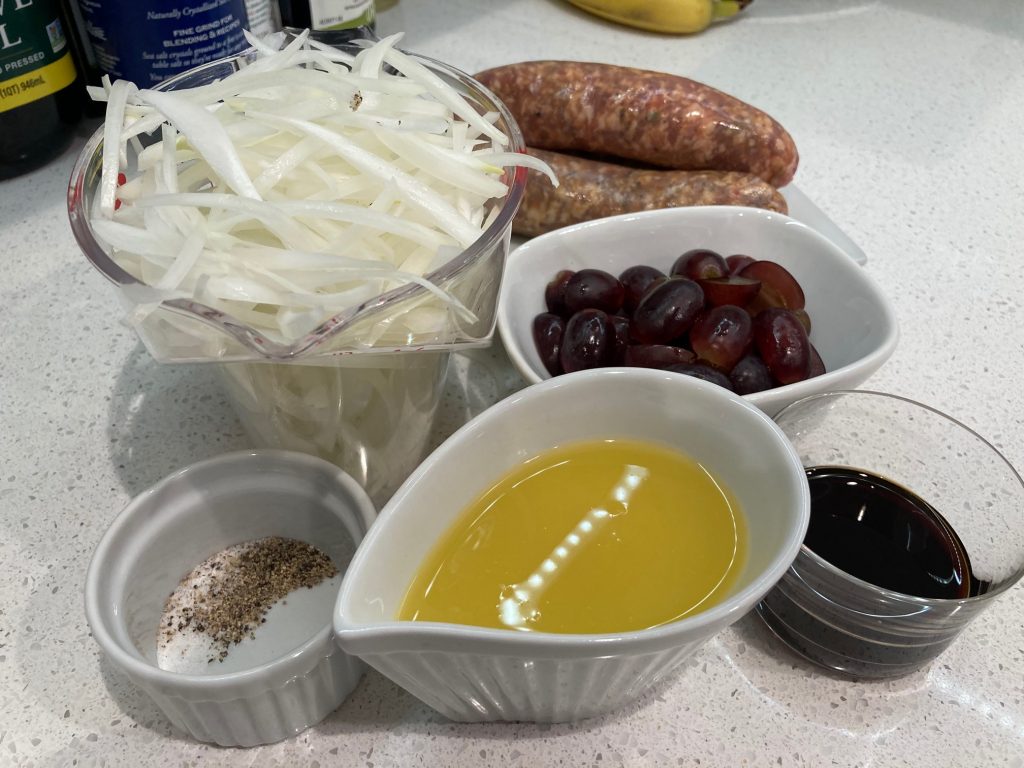
Key to this recipe (in addition to high quality, sweet Italian sausage) is the selection of the Balsamic Vinegar. If you choose to use a thin, tart grocery store brand, you will miss the mark. We propose two richer vinegars from Modena, Italy:
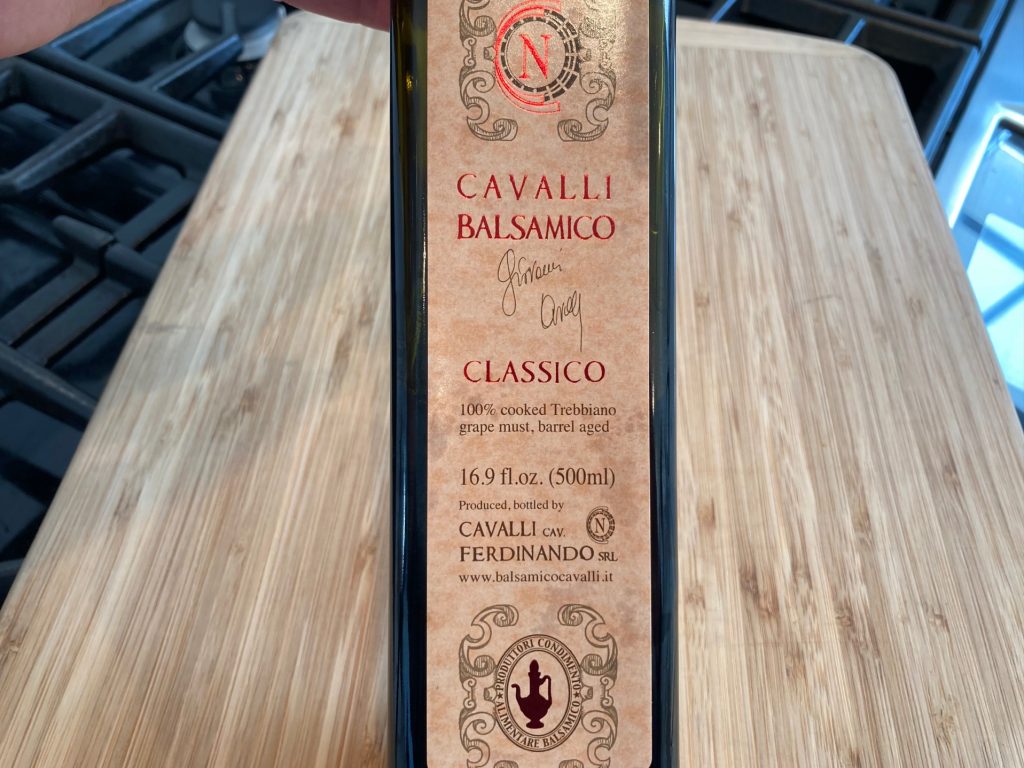
Cavalli Balsamico 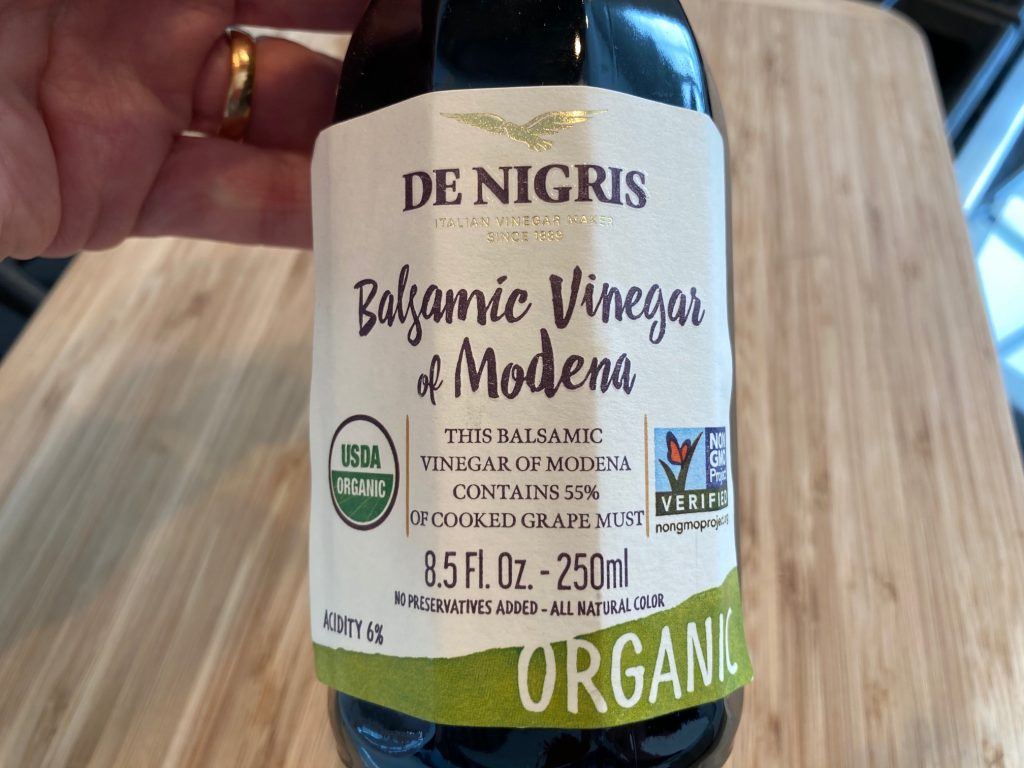
De Nigris Balsamic
The Cavalli Balsamico ($25) is our go-to vinegar for salads. It’s rich and concentrated, with plummy sweetness from the grape must (no added sugars). If your preference is for sweet over savory, this is the vinegar for you. The De Nigris ($20) is a bit less concentrated and less sweet, but complex and full-bodied, with a bit more acidity than the Cavalli. In Bond-speak, think Roger Moore vs. Daniel Craig. After trying the recipe with both vinegars, our vote was for the De Nigris, mirroring our preference for Craig.
Wine Pairing
In view of the vinegar/sautéed onions/red grapes driving the flavors of this dish, we wanted a wine with enough acidity to handle the vinegar but sweet enough to complement the onions & grapes. And because it’s balsamic vinegar, it had to be a red wine. We immediately thought of the grape Grenache (or Garnacha if Spanish). But Grenache from what part of the world? France, Spain, Sardinia, USA??? For brevity sake, we focused on two expressions of this grape – one lighter-styled, and one more extracted.
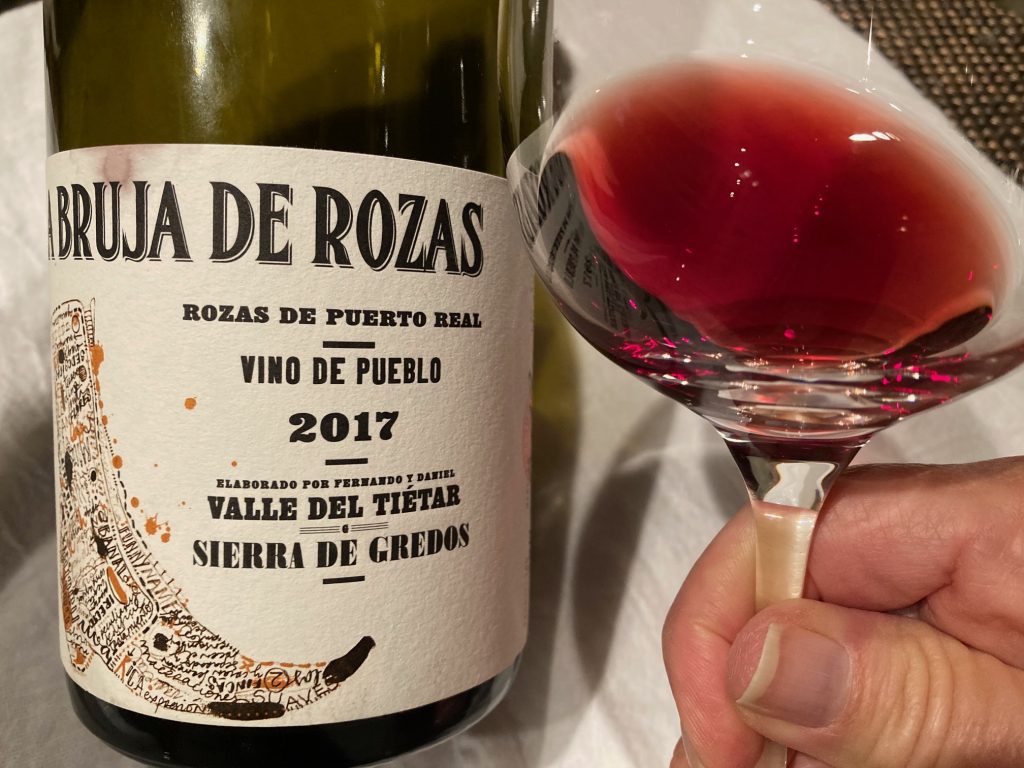
Comando G Bruja de Rozas 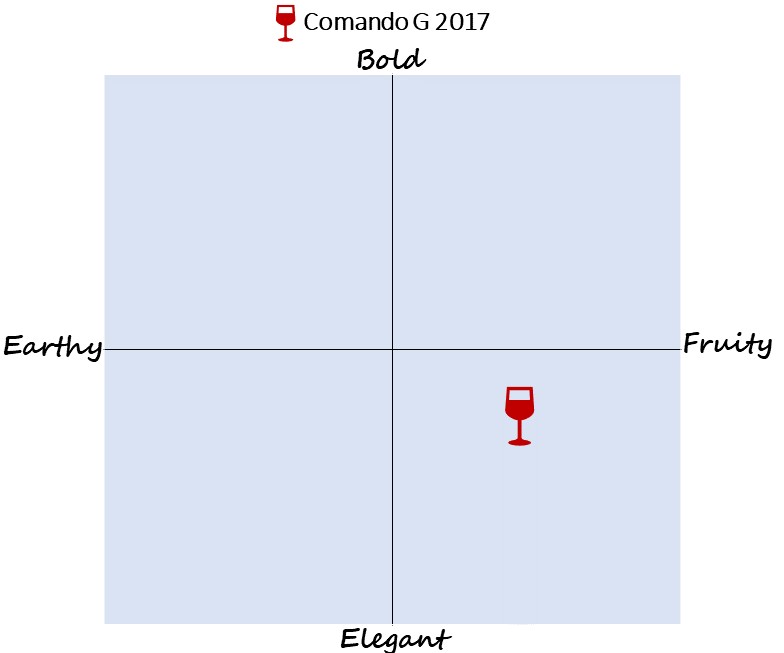
Comando G Bruja de Rozas 2017 ($30) is a light-styled Garnacha is from the Sierra de Gredos, a mountain range near Madrid. The fruit is from vines 50 to 80 years old, biodynamically farmed on sandy soils of granite, slate and quartz at an elevation of 2700 ft. All serve to produce a pale ruby wine filled with energy and rich red fruit. We totally agree with Decanter Magazine’s description of Comando G: “elegant, mineral and refreshing . . . (a) thrilling, modern expression of Garnacha.” In our view, this is a terrific food wine with grilled meats and burgers.
For a more extracted style, we chose a Grenache from Domaine Santa Duc Grand Grenache 66 2010 ($109) from the Gigondas region of France’s Southern Rhone. Made from biodynamically farmed vines that range in age from 50 to 110 years old, the wine maker said that only the best lots from the vintage were selected for this wine, the most expensive in the Santa Duc lineup.
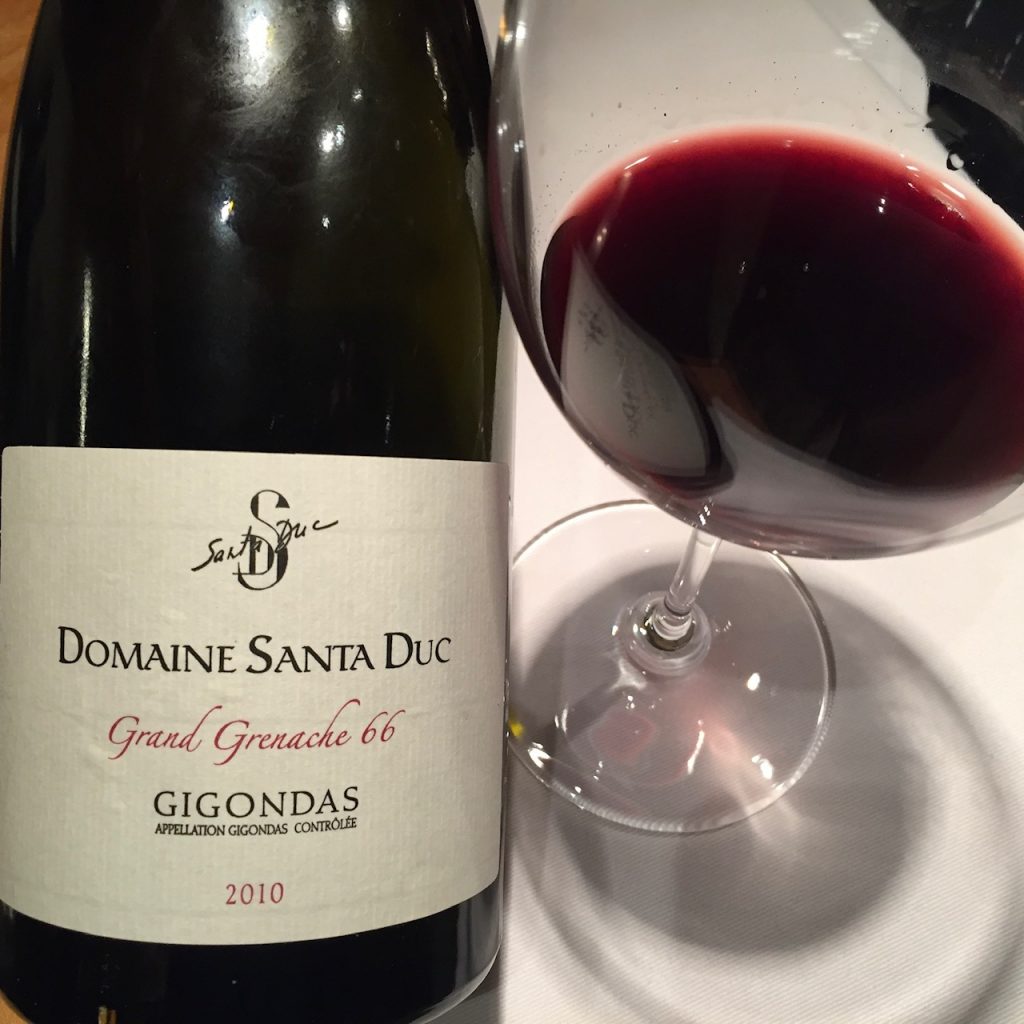
Santa Duc Grand Grenache 66 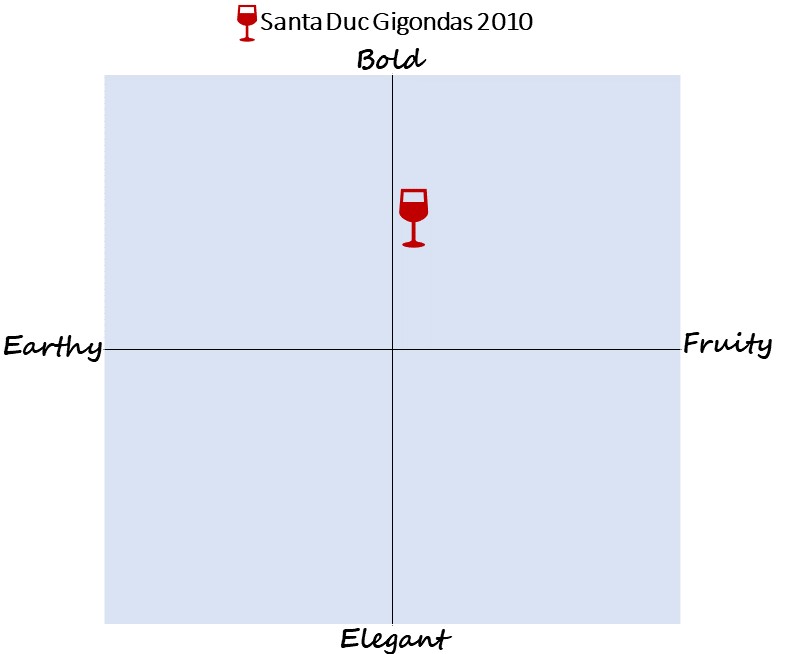
The wine’s color in the photo above tells all. This Grand Grenache is rich and fleshy, with dark fruits, silky tannins, and a very long spice-filled finish. Stylistically, this Gigondas is quite different from the lighter, refreshing Comando G; a consequence of the Gigondas’ soils (more clay), elevation (lower) and extraction (higher). Note that Santa Duc now markets a 100% Grenache wine as Chateauneuf du Pape La Crau Ouest.
We love this Gigondas wine but feel it pairs better with richer, heavier fare like braised Short Ribs, Osso Buco, and Cassoulet. If you’ve not tried the wines of Domaine Santa Duc, we recommend you start with their Grenache blends – Clos Derriere Vieille ($48) or Les Aubes from Vacqueyras ($27). Both are 80% Grenache.
Regardless of the Grenache/Garnacha you choose, give this recipe a go. Cooking with vinegar, as showcased here and in our Chicken Escabeche post, will brighten your favorite comfort food.
Notes
Sausages: if browning in the saute pan, prick the sausages before browning. If grilling the sausages, prick the sausages after you return them to the pan with the onions. The idea is to retain the sausage juices, allowing them to commingle with the onions.
Ingredients
- 3 Tbs Olive Oil
- 8 links Sweet Italian Sausage (about 1-3/4 lbs.). See note below.
- 1 large yellow onion, thinly sliced (about 2 cups)
- Kosher salt
- 2 Tbs. balsamic vinegar (preferably Cavalli Balsamico Classico)
- 1/2 cup lower salt chicken broth
- 20 seedless red grapes, halved
- 2 Tbs. chopped fresh oregano
Instructions
- Heat 1 Tbs. of the olive oil in a large saute pan over medium heat until it is shimmering hot, about 2 minutes.
- Add the sausages, browning them on all sides for about 8 minutes total.
- Transfer the sausages to a warm plate. Do not wipe out the pan.
- Add the remaining 2 Tbs. olive oil and the onions. Sprinkle with 1/2 tsp. of salt and cook until the onions soften and only begin to brown, about 7-8 minutes.
- Add the balsamic vinegar and scrap the bottom of the pan with a wooden spatula to integrate any brown bits.
- Reduce the heat to a gentle simmer, add the sausages and grapes to the pan and cover with the lid ajar.
- Cook for 15 minutes, rotating the sausages periodically. Check for doneness. Cook longer if needed to insure the sausages are cooked through.
- Plate the sausages with the onions and grapes. Sprinkle with fresh oregano.

Elizabeth Mannen Berges says
Steve, you always send me straight to the grocery, salivating…and the wine store. Running out to the pool deck with Fiona to clip the oregano now. Miss you guys. e
Steven says
Thanks for commenting, Elizabeth. Hope you guys are vaxxed and healthy.
Jen Cook says
Everything you post, food and wine, sounds delicious!!
Steven says
Thanks for commenting, Jen. We are looking forward to seeing you and Andrew.
Tom Ortwein says
You described it well enough for me to almost taste the food and compare the pairings. Well done!
Steven says
Thanks for commenting, Tom. I was thinking you and Linda when I typed “Wurstl”.